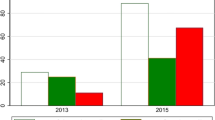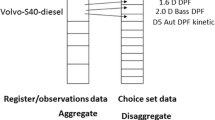Abstract
It is common practice in choice modelling to include the socioeconomic characteristics of other members of a household in the utility expressions associated with the preferences of a particular individual. By including household descriptors, the analyst is assuming that other household members can influence the choices made by the household as if the preference weights (or marginal utilities) are reflective of equal influence of all members of a household. In reality it is likely that there is a power relationship that underlies the contribution of the individual whose preferences are being studied and the contribution of other household members, typically proxied by a number of socioeconomic descriptors. In this paper we condition the individual and the household explanatory variables on an additional parameter that represents the influence or power that each agent has in the revelation of the preferences of a sampled individual. Using a data set of the stated choice of automobile fuel type (petrol, diesel, hybrid), we estimate a nonlinear model to identify the strength of the power relationship, and find that the power contribution of the household members to the individuals choice vary across alternatives. The model with the power relationship is found to be a statistical improvement and delivers substantially different elasticities than the traditional model with household characteristics.




Similar content being viewed by others
Notes
The method developed in this paper can be implemented with revealed preference data (if it is available), although we do not see such data as being suitable for the application in this paper where one alternative, the hybrid fuel source, is essentially a new alternative (at the time of the survey it was less than one percent of the market share), and where the main attributes of interest are not currently in place in the market.
The choice experiment was deliberately designed such that it could capture behaviour in a future where alternative vehicle technology was competitive with existing vehicle attributes. As such there was no restriction placed on range or refuelling options of the hybrid alternative. Additionally the hybrid alternative was only specified as being a vehicle type that was a fuel source that was alternative to the current dominant market options. While other studies typically specify the hybrid as being some variant electric “hampered” by current limitations on range and price competitiveness, this survey was deliberately designed to be free of those restrictions.
In terms of alternative acceptability, in 14 % of choice tasks all alternatives were acceptable, in 46 % one alternative was unacceptable, in 29 % two alternatives were unacceptable and in eleven percent of choice tasks all three alternatives were unacceptable to respondents. The petrol alternative was unacceptable in 42 % of choice tasks, the diesel alternative in 51 % and the hybrid in 44 %. With respect to certainty, respondents were reasonably certain about the choices they made, with an average of 7.20 (with a standard deviation of 2.22) on a scale from Very Unsure (1) to Very Sure (10).
A referee suggested we use a hold out sample on a subset of the design. This is something worth considering in future research with a larger sample, but the overall sample size of our dataset is too small to be removing a sufficiently large sample to test the referees request. Removing part of the optimal design to test on the same people, is not strictly a hold out sample.
References
Beck, M., Hensher, D.A., Rose, J.M.: Report of a Pilot Survey for the Automobile Choice Project. University of Sydney, Institute of Transport and Logistics Studies (2009)
Beck, M.J., Rose, J.M., Hensher, D.A.: Behavioural responses to vehicle emissions. Transportation 38(3), 445–463 (2011)
Beck, M.J., Chorus, C.G., Rose, J.M., Hensher, D.A.: Vehicle purchasing behaviour of individuals and groups: regret or reward? J. Transp. Econ. Policy 47(3), 475–492 (2013a)
Beck, M.J., Rose, J.M., Hensher, D.A.: Consistently inconsistent: The role of certainty, acceptability and scale in automobile choice. Transp. Res. Part E 56(1), 81–93 (2013b)
de Palma, A., Picard, N. and Ignacio I.: Discrete choice decision-making with multiple decision makers within the household. Mimeo (2014)
Hensher, D.A., Rose, J.M.: The influence of alternative acceptability, attribute thresholds and choice response certainty on automobile purchase preferences. J. Transp. Econ. Policy 46(3), 451–468 (2012)
Hensher, D.A., Beck, M.J., Rose, J.M.: Accounting for preference and scale heterogeneity in establishing whether it matters who is interviewed to reveal household automobile purchase preferences. Environ. Resour. Econ. 49, 1–22 (2011)
Hensher, D.A., Rose, J.M., Greene, W.H.: Applied Choice Analysis, 2nd edn. Cambridge University Press, Cambridge (2015)
Rose, J., Bliemer, M.: Stated preference experimental design strategies. In: Hensher, D.A., Button, K.J. (eds.) Handbook of Transport Modelling, pp. 151–179. Elsevier, Oxford (2008)
Timmermans, H.J.P., Zhang, J.: Modeling household activity travel behavior: examples of state of the art modeling approaches and research agenda. Transp. Res. Part B 43(2), 187–190 (2009)
Zhang, J., Fujiwara, A.: Representing household time allocation behavior by endogenously incorporating diverse intra-household interactions: A case study in the context of elderly couples. Transp. Res. Part B 40(1), 54–74 (2006)
Zhang, J., Timmermans, H., Borgers, A.: Utility-maximizing model of household time use for independent, shared, and allocated activities incorporating group decision mechanisms. Transp. Res. Rec. 1807, 1–8 (2002)
Zhang, J., Kuwano, B., Lee, B., Fujiwara, A.: Modeling household discrete choice behavior incorporating heterogeneous group decision-making mechanisms. Transp. Res. Part B 43(2), 230–250 (2009)
Acknowledgment
The research contribution is linked to an Australian Research Council grant DP140100909 (2014–2016) on ‘Integrating Attribute Decision Heuristics into Travel Choice Models that accommodate Risk Attitude and Perceptual Conditioning’. The comments of two referees have and Elisabetta Cherchi have materially improved this paper.
Author information
Authors and Affiliations
Corresponding author
Rights and permissions
About this article
Cite this article
Hensher, D.A., Ho, C. & Beck, M.J. A simplified and practical alternative way to recognise the role of household characteristics in determining an individual’s preferences: the case of automobile choice. Transportation 44, 225–240 (2017). https://doi.org/10.1007/s11116-015-9635-9
Published:
Issue Date:
DOI: https://doi.org/10.1007/s11116-015-9635-9




